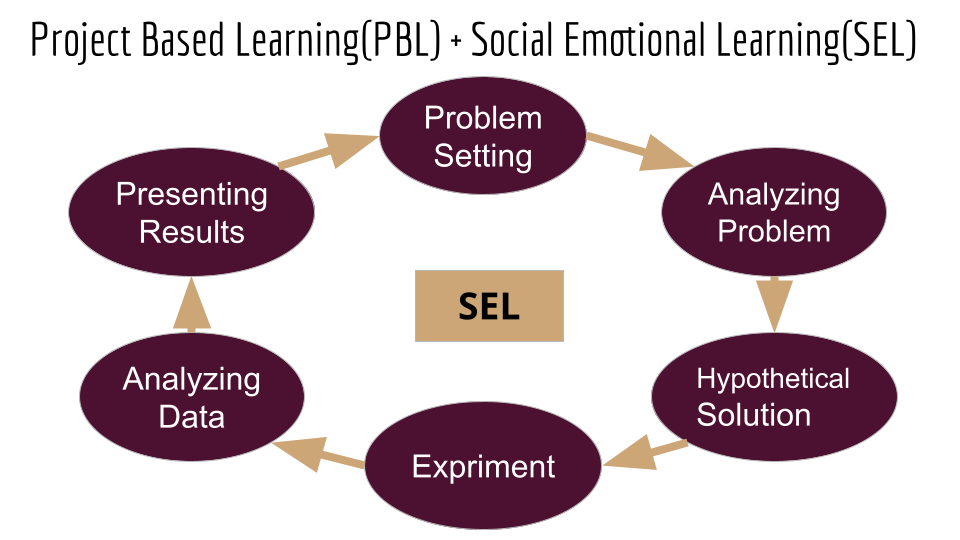(English)Fostering Student Agency
2024.04.01
As the OECD suggests, a sense of agency is essential for students in this complicated and ever-changing world. Student agency for 2030 is rooted in the belief that students have the ability and the will to influence positively their own lives and the world around them. Jiyugaoka Gakuen High School offers an education that gives first-year students a sense of student agency and skills for well-being. The goal is for students to enjoy collaboration and contribute to a better world by cooperating with their peers worldwide. To achieve this, we are developing course content that combines social and emotional learning (SEL), problem-based learning (PBL), and the Science, Technology, Engineering, Arts, and Mathematics (STEAM) approach so that each student can identify and reach their goals.
1. Class design
The class is designed to provide a simplified experience of what is done in society by following the process of projects, often conducted in research and product development. Specifically, as shown in Figure 1., students will spend one year learning how to collaborate with diverse people, setting the problem, understanding the problem, proposing a hypothesis and solution, designing the experiment, conducting the experiment, analyzing the results, and making a proposal. The students can freely decide on project members, and members can be changed during the class, which often happens in the real world. The target group for this class is boys and girls between the ages of 15 and 17. In 2023, approximately 400 students took this class.

To connect the experience in a class to activities in society, opportunities are provided for students to collaborate online or in person with companies, local people, and high school students from overseas in after-school activities, as shown in Figure 2. Currently, the Honada Research Institute Japan (HRIJ) is providing opportunities for collaboration. In 2023, the HRIJ and our student participated in the Internet Governance Forum 2023, organized by the UN in Kyoto, Japan. He spoke about his experience working with the international team at the institute.

2. Example and observation
The following section explains the class contents in detail. However, since these observations are subjective, they must be verified with statistical methods in the future. About 400 students formed 113 teams in the class and proposed problems, more than a quarter related to sleep. Sleep has been treated as an essential factor for students’ well-being from the point of view of stress resistance since the first results from the survey of Social and Emotional Skills. Therefore, the following section explains sleeping-related activities as an example.
2.1 Learning social emotional skills
Before starting projects, students learn social emotional skills using the SEE Learning textbook developed by Emory University. They learn and think about well-being, common humanity, kindness, thinking traps, and system thinking. These are the skills needed for enjoyable collaboration.
2.2 Problem setting
Each person begins this step by observing themselves and their surroundings. They then post what they believe to be their issues, unnamed, on the online whiteboard and share them with their classmates. Then, students with similar interests formed teams. In the real world, people with similar values often start up NPOs or companies, and this program is designed to allow students to experience this on a small scale. In addition, since some high school students are interested in entrepreneurship, the program is also designed to enable students to experience online applications that many companies use.
2.3 Analyzing problem
Since the topic is related to individuals’ daily lives, they observed their daily behaviors and conducted surveys to understand the issues. While discussing and making presentations among classmates, students found that the details of the same problem of “not being able to sleep” varied from person to person.
2.4 Hypothetic solution
Hypotheses are created and shared with peers by drawing cartoons. Each team is given three frames on the online whiteboard to draw a cartoon. In the first frame, they are asked to draw what they are currently having trouble with, and in the third and final frame, they are asked to draw what they are happy about when it is solved. Then, ask each team to consider what they want to put in the second frame. This second frame will be their hypothesis.
2.5 Experiment
In this section, we ask the teams to think freely about how they will test the hypothesis they have come up with to see how well it works. Since each team will have a different problem, the locations of the experiment can be home, school, community, or online. Here, they learn how to gather and share data with their teams and aggregate it, but how to do it is left up to each team. One of the purposes of allowing teams to design their experiments freely here is to let them experience that it is expected to fail at first and that people learn and grow from their mistakes.
For example, the team with problems falling asleep researched and practiced relaxation methods for falling asleep and implemented the relaxation methods. Another team that had problems sleeping because they spent too much time looking at their smartphones put their smartphones in a box so that they could not use them, and reported that sleeping for 8 hours made them feel better the next day, that they could finish their homework faster if they could not use their smartphones, and that it had no effect.
2.6 Analyzing Data
The analysis will be done by students analyzing and verbally explaining to their classmates the relationship between their problem, hypothesis, and data. Because of the wide variety of data to be collected (numerical, photographic, video, text data, etc.) and the lack of time to teach detailed methods of analysis appropriate for each team, we do not teach detailed methods of study in this class but encourage students to discover techniques of analysis in the process of learning in other courses. For example, in a math class, students might say, “Oh, I might be able to use this to analyze data!” They might discover that they can use this to analyze data. The goal of this class is for students to experience the joy of solving something on their own, understand that what they learn in class is helpful, and improve their ability to engage with the class content independently.
2.7 Presenting results
The purpose here is to practice communicating what you have thought about and verified to an audience in a way that is easy to understand. The purpose is also to provide an opportunity for each student to express himself/herself by making the most of his/her talents. Each team is asked to choose the method of presentation that they think will best convey their point in an easy-to-understand manner. Presentations are made using regular slides, but in other cases, a 2D character is made to speak with a synthetic voice.
3. Discussion
Students could freely research their interests with their peers, spark conversation, and generate creative ideas. The trend toward fewer absences may also be because students in this class always have a topic to discuss with their peers, but further investigation is needed.
Many students believe that sleep issues are personal and must be resolved independently. Yet data show that sleep is strongly associated with stress resistance and that sleep universally affects well-being, and SSES2024 also tracks sleep status. In the future, we hope to use this data to create opportunities for adolescents to discuss sleep as a universal problem and gain experience in improving it with their peers worldwide.
The female students who chose issues related to makeup and hairstyles were actively involved in hypothesis building and data collection and spontaneously researched the scientific background of the problem. We believe female students are more likely to engage in science content if it interests them actively.
The following are messages about what they learned in the class from students who took this class.
The importance of kindness to others./I found actions I should take to improve the quality of my sleep./Planning and action are necessary to achieve goals./Freedom of speech./How to solve problems that occur in everyday life./My future./I’ve learned that it’s essential to think./Thinking about each subject/problem (in detail about causes, solutions, etc.)/Sharing of ideas and interest in each other’s opinions./Exchanging ideas with others./Ability to think for oneself and speak up./Importance of setting goals.
For this class to be successful, it is essential to build an environment where people feel safe talking about anything, enjoy making mistakes, and help each other out. We would also like to continue collaborating with the OECD Social and Emotional Survey (SSES) Team, as high-quality data and expert knowledge are essential to designing classes that meet the interests of high school students and support them.

-
今井 朝子(株)日立製作所にて研究開発に従事した後、アメリカの企業にて東京大学とイリノイ大学とのVRの国際研究プロジェクトに参加し、アプリケーション開発に従事。その後ユーザビリティーに関するフリーランサーとして多数企業の新規事業提案等に携わる。現在、総務省情報通信審議会専門委員、Salzburg Global Seminar Fellow(世界をより良くするために活動しているリーダーのための国際NPO)、Karanga執行役員(社会性と情動の学び、生きる力の学びを広めるために活動している国際アライアンス)群馬県非認知教育専門家委員会委員、SEL Japan 運営メンバーを兼務。
<経歴>
・慶應義塾大学理工学部卒業
・慶應義塾大学大学院理工学研究科物理学専攻 修士課程修了
・イリノイ大学コンピュータサイエンス科 修士課程修了
・東京大学大学院工学系研究科先端学際工学専攻博士課程修了


 LINE
LINE


